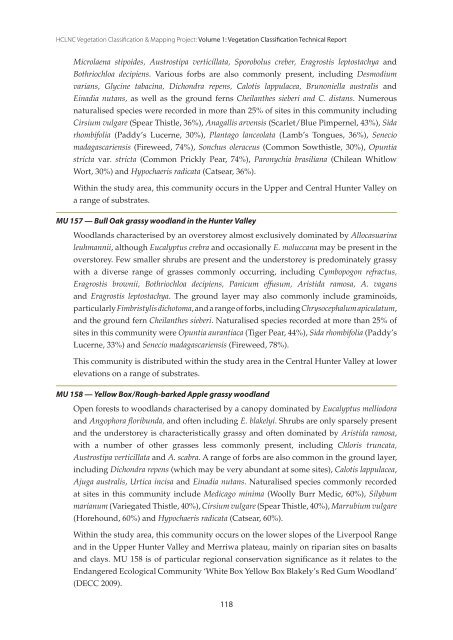Free Download - HCCREMS
Free Download - HCCREMS
Free Download - HCCREMS
You also want an ePaper? Increase the reach of your titles
YUMPU automatically turns print PDFs into web optimized ePapers that Google loves.
HClNC Vegetation Classification & mapping Project: Volume 1: Vegetation Classification Technical Report<br />
Microlaena stipoides, Austrostipa verticillata, Sporobolus creber, Eragrostis leptostachya and<br />
Bothriochloa decipiens. Various forbs are also commonly present, including Desmodium<br />
varians, Glycine tabacina, Dichondra repens, Calotis lappulacea, Brunoniella australis and<br />
Einadia nutans, as well as the ground ferns Cheilanthes sieberi and C. distans. Numerous<br />
naturalised species were recorded in more than 25% of sites in this community including<br />
Cirsium vulgare (Spear Thistle, 36%), Anagallis arvensis (Scarlet/Blue Pimpernel, 43%), Sida<br />
rhombifolia (Paddy’s Lucerne, 30%), Plantago lanceolata (Lamb’s Tongues, 36%), Senecio<br />
madagascariensis (Fireweed, 74%), Sonchus oleraceus (Common Sowthistle, 30%), Opuntia<br />
stricta var. stricta (Common Prickly Pear, 74%), Paronychia brasiliana (Chilean Whitlow<br />
Wort, 30%) and Hypochaeris radicata (Catsear, 36%).<br />
Within the study area, this community occurs in the Upper and Central Hunter Valley on<br />
a range of substrates.<br />
MU 157 — Bull Oak grassy woodland in the Hunter Valley<br />
Woodlands characterised by an overstorey almost exclusively dominated by Allocasuarina<br />
leuhmannii, although Eucalyptus crebra and occasionally E. moluccana may be present in the<br />
overstorey. Few smaller shrubs are present and the understorey is predominately grassy<br />
with a diverse range of grasses commonly occurring, including Cymbopogon refractus,<br />
Eragrostis brownii, Bothriochloa decipiens, Panicum effusum, Aristida ramosa, A. vagans<br />
and Eragrostis leptostachya. The ground layer may also commonly include graminoids,<br />
particularly Fimbristylis dichotoma, and a range of forbs, including Chrysocephalum apiculatum,<br />
and the ground fern Cheilanthes sieberi. Naturalised species recorded at more than 25% of<br />
sites in this community were Opuntia aurantiaca (Tiger Pear, 44%), Sida rhombifolia (Paddy’s<br />
Lucerne, 33%) and Senecio madagascariensis (Fireweed, 78%).<br />
This community is distributed within the study area in the Central Hunter Valley at lower<br />
elevations on a range of substrates.<br />
MU 158 — Yellow Box / Rough-barked Apple grassy woodland<br />
Open forests to woodlands characterised by a canopy dominated by Eucalyptus melliodora<br />
and Angophora floribunda, and often including E. blakelyi. Shrubs are only sparsely present<br />
and the understorey is characteristically grassy and often dominated by Aristida ramosa,<br />
with a number of other grasses less commonly present, including Chloris truncata,<br />
Austrostipa verticillata and A. scabra. A range of forbs are also common in the ground layer,<br />
including Dichondra repens (which may be very abundant at some sites), Calotis lappulacea,<br />
Ajuga australis, Urtica incisa and Einadia nutans. Naturalised species commonly recorded<br />
at sites in this community include Medicago minima (Woolly Burr Medic, 60%), Silybum<br />
marianum (Variegated Thistle, 40%), Cirsium vulgare (Spear Thistle, 40%), Marrubium vulgare<br />
(Horehound, 60%) and Hypochaeris radicata (Catsear, 60%).<br />
Within the study area, this community occurs on the lower slopes of the Liverpool Range<br />
and in the Upper Hunter Valley and Merriwa plateau, mainly on riparian sites on basalts<br />
and clays. MU 158 is of particular regional conservation significance as it relates to the<br />
Endangered Ecological Community ‘White Box Yellow Box Blakely’s Red Gum Woodland’<br />
(DECC 2009).<br />
118


